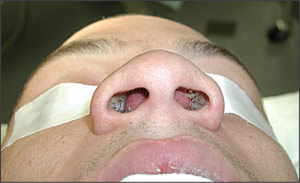
Am Fam Physician. 2006;73(9):1617-1618
A 25-year-old man presented with complaints of midfacial pain, fever, and general malaise of about 48 hours' duration. He denied having a cough, rhinorrhea, or nasal congestion. The patient reported being hit in the nose about 10 days earlier and had received no interval treatment. The patient's temperature was 100.6° F (38.1° C) orally and he had no frontal or maxillary sinus tenderness. Nasal examination revealed bilateral midline nasal swelling (see accompanying figure). The rest of the physical examination was unremarkable.

Question
Discussion
The answer is B: septal hematoma. The midline swelling of the septum is typical of septal hematoma and is consistent with the patient's history of facial trauma. Typically soft and fluctuant when compressed, a septal hematoma is a collection of blood between the nasal mucosa and the cartilaginous septum. It may occur unilaterally or, more commonly, bilaterally following nasal trauma with or without associated nasal fracture. This urgent condition warrants immediate referral to an otolaryngologist.
Management of septal hematoma includes local anesthesia with needle aspiration or incision and drainage. Several days of nasal packing prevents reaccumulation of blood. Ideally, treatment occurs within a few hours of injury.1 If the hematoma is not cleared, the septal cartilage may become necrotic and result in a saddle nose deformity or septal perforation. Accumulated blood may become infected, and antibiotics should follow drainage if abscess is noted. In this patient, fever suggested infection, and this was confirmed after incision and drainage.
Patients with sinusitis typically report fever and malaise, as well as frontal or mid facial pain and/or maxillary pain. Physical examination often reveals sinus tenderness, mucopurulent discharge, and inflamed nasal turbinates. However, the nasal turbinates arise from the lateral nasal wall and do not appear as midline swelling.
Nasal polyps result from a profound inflammatory response, with resultant swelling of the respiratory epithelium of the nasal and sinus mucosa. Although their exact etiology is not understood completely, nasal polyps often coexist with chronic sinusitis or chronic nasal allergies.2
Foreign bodies, such as pebbles or beads, may be found in the nares of children or developmentally disabled adults. They may present with foul-smelling nasal discharge or signs of nasal obstruction.
Viral syndrome may present with malaise, fevers, and clear to mucopurulent nasal dis charge. Swelling of the nasal septum is not usual finding, although inflamed turbinates may be noted.
| Condition | Characteristics |
|---|---|
| Sinusitis | Inflamed nasal turbinates with moderate to marked swelling, mucopurulent discharge |
| Septal hematoma | Pink, soft, midline swelling of the septum |
| Nasal polyps | Smooth, glistening nodules, bluish to fleshy in color |
| Foreign body | Object typically along floor of nose in anterior vestibule |
| Viral syndrome | Inflamed turbinates, clear to mucopurulent discharge |